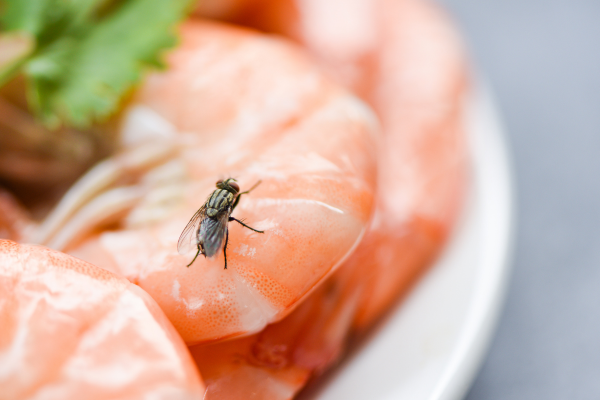Your cart is currently empty!

18 Aug Health Risks Associated With House Flies
House flies are not just a nuisance buzzing around our homes; they also pose significant health risks. These seemingly harmless insects can transmit various diseases, making them potential carriers of pathogens that can compromise human health and food safety. In this article, we will examine the health risks associated with house flies, and identify how they pose risks to human health and food safety.
House flies are attracted to a wide range of environments, including areas with decaying organic matter, garbage, and animal waste. As they land on these surfaces, they come into contact with pathogens that can adhere to their bodies and mouthparts.
Here are some of the diseases that house flies can potentially transmit:
- Gastrointestinal Infections: House flies can transmit pathogens such as Salmonella, Escherichia coli (E. coli), and Shigella, which cause gastrointestinal infections. These bacteria can contaminate food and water sources when flies land on them, potentially leading to foodborne illnesses when consumed.
- Typhoid Fever: House flies can carry Salmonella typhi, the bacterium responsible for causing typhoid fever. This serious bacterial infection can lead to high fever, abdominal pain, diarrhoea, or constipation, and in severe cases, can be life-threatening.
- Cholera: House flies have been implicated in the transmission of Vibrio cholera, the bacterium that causes cholera. Cholera is a diarrheal disease that can spread rapidly, particularly in areas with inadequate sanitation and hygiene practices.
- Diarrheal Diseases: Other diarrheal diseases caused by pathogens such as Campylobacter, Cryptosporidium, and Giardia can also be transmitted by house flies. These diseases can cause severe gastrointestinal symptoms, leading to dehydration and long-lasting health complications.
- Eye Infections: House flies can transmit pathogens that cause eye infections, including conjunctivitis (pink eye). When flies land on surfaces and then come into contact with the eyes, they can introduce bacteria or other microorganisms, leading to eye infections.
In addition to the direct transmission of diseases, house flies can also contaminate food and food preparation surfaces, posing a risk to food safety. They regurgitate and excrete as they feed, potentially transferring pathogens from their bodies onto food. This can lead to the contamination of ingredients, utensils, and even cooked meals, increasing the risk of foodborne illnesses when consumed.
It is important to note that while house flies can carry and transmit pathogens, not every fly will be infected, and not every encounter will result in disease transmission. However, the potential risks are significant, especially in environments with poor sanitation and hygiene practices.
To mitigate the health risks associated with house flies, it is essential to take preventive measures:
- Proper Sanitation: Maintaining cleanliness and proper sanitation is crucial in minimizing the attraction of house flies. Regularly dispose of garbage in sealed containers, clean up pet waste promptly, and ensure proper sanitation practices in food preparation areas.
- Food Storage: Store food in sealed containers to prevent access by house flies. Cover fruits and vegetables, and keep them in the refrigerator whenever possible. By reducing access to food sources, you can discourage fly activity.
- Fly Control Measures: Implement appropriate fly control measures, such as using fly screens on doors and windows, and employing fly traps or sticky traps designed to capture and eliminate house flies. These methods can help reduce the fly population in and around your living spaces.
- Personal Hygiene: Practicing good personal hygiene is important in minimizing the risk of disease transmission. Wash hands thoroughly with soap and water, especially before handling food, after using the restroom, or after contact with potentially contaminated surfaces.
Remember, prevention is key. By creating an environment that is less attractive to house flies and by implementing appropriate control measures, we can help safeguard our health and promote a safer, healthier living space for ourselves and our loved ones.
It’s time to take action and put an end to this problem. Don’t let house flies continue to pose health risks and compromise your comfort. Visit the Environmental Factor website today and order your Nematodes Globe EFI Sticky Traps. Take control of your living space, protect your family’s health, and ensure food safety. Together, we can create a fly-free environment that promotes a healthier and happier home.


